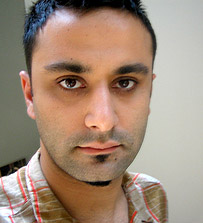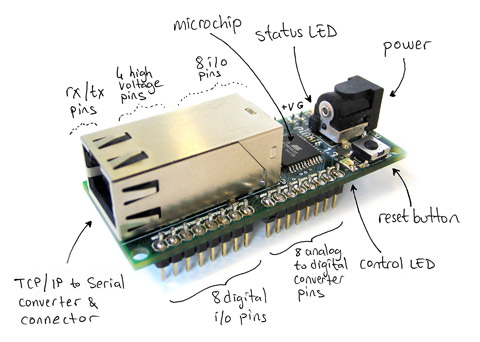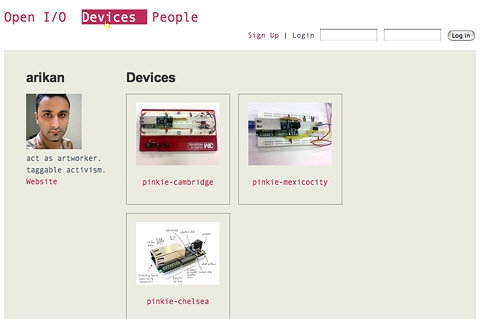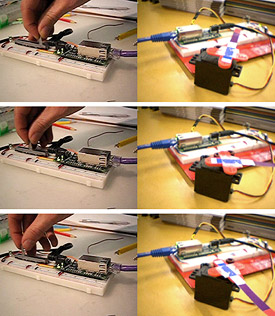Since John Maeda‘s group at the MIT Media Lab has been renamed from Aesthetics + Computation Group (out of which Processing emerged) to Physical Language Workshop, also the focus of interest there slightly shifted. Physical hints less at physical computing than on a general interest in the mechanisms in which the world of networked systems interacts with the various worlds around it, for example with the world of art and that of economy.
We will have a closer look at the current main project Openstudio next week and start off with an interview of PLW’s most recent graduate, Burak Arikan. In his work, he is indeed taking the interaction to a physical level by designing tools for “exploring electronic compositions through social means” in his projects Pinkie and Open I/O:
 Burak, could you please tell us a bit about your background?
Burak, could you please tell us a bit about your background?
I grew up in Istanbul. It is a very complex place to live. Many social classes, lots of immigrants, beautiful geography, various religions, east west and in between, layers of culture, etc. etc. As a kid I played both on the streets and at home with computers.
I started designing and developing web sites with my friends during my civil engineering studies at Yildiz Technical University. I did some some personal projects and commercial work. After finishing the engineering degree, I went to graduate school and studied Visual Communication Design at Istanbul Bilgi University. While studying communication design, I also worked as a visual designer and information architect with several teams and Internet companies in Istanbul. I moved to Baltimore in 2003 and built commercial projects including community web sites, telecom / web products, shopping sites, and social networking services. I ceased all the commercial activity in the summer of 2004 to attend graduate school at MIT.
I recently completed my master’s degree at the MIT Media Laboratory in the Physical Language Workshop led by John Maeda. While at MIT, I pursued research exploring systems that address the transition from connectivity to collectivity in the context of creative expression. My current work is focused on building platforms for artists and designers that enable collectivity based on composing distributed electronic objects over the Internet.
As an artistic exploration, I build systems that evolve with the interactions of people and machines, and I show the instances of these systems through diverse media including prints, animation, software, electronics, and physical materials. In my work, I am trying to use technology both as a medium and as a critique.
What’s Pinkie and Open I/O?
Pinkie is a network based electronics prototyping board. With my friend Vincent Leclerc, we developed it as a precursor to building large networked systems that incorporate physical space and objects. Pinkie has been designed to easily compose sensors and actuators that reside in different locations. Pinkies are inherently invisible, they hide behind the structures and only serve as facilitators to interface the physical world to the digital network. Today creating architectural spaces connected to digital networks is possible, but not so easy or sustainable. Furthermore, it is not well practiced. So how does the design of spaces and objects change when they are networked? How do we situate communication / interaction technologies? What are the qualities of our experience in these spaces? To explore these questions we started to develop a new project called Open I/O.

Open I/O is a suite of software services and applications for composing and running distributed electronic media in a way that enables people to exchange data over the Internet. By using this system, artists and designers can collaborate and take advantage of high-level social and economic information while creating low-level physical interactions.
So in a way Pinkie is the little piece of hardware which actually connects the physical space to the informational one. This puts it in a very interesting spot in today’s discourse, maybe even the most neuralgic one. How do you think that projects built upon this could actually enrich “the qualities of our experience”?
I think the qualities of our networked experience can be better if artists and designers can do hands-on-networking. However, network technologies are really complex or controlled by who ever builds them. We developed Pinkies for artists and designers to easily and intuitively prototype ideas about networked objects and space. When we use a Pinkie to control a sensor, the data sensed from the world can immediately be online. So with Pinkies, the physical world is connected to the informational one by default. Starting from this default situation, we can focus more on the quality of relationships – protocols – among machines, people, objects, and space.
As I understand, Open I/O is social networking for Pinkies? Or is it rather aimed at their makers or even users? How does it work in detail and could it facilitate the exchange of data in a more relevant way than purely screen-based networking?
Open I/O works like a peer-to-peer file sharing program, rather then sharing media files in your PC, you share data sensed from your physical environment. While Pinkies are organizing the low-level information (e.g., sensing the world), Open I/O is for higher concepts such as managing distributed devices, collaboration, and social networking. Open I/O (OIO) combines a standalone dispatcher software, OIO Dispatcher, facilitating the communication between Pinkies; and a central service, OIO Server, enabling people to find each other’s devices all over the world.

We think that social environments are instrumental in artistic production, so we are building Open I/O as a platform for exploring electronic compositions through social means. We use some common social networking typologies such as profiles, relationship tracking, activity logging, profile history, invitations and so on. Not only people, but also Pinkies have profile pages in Open I/O. From a person profile we see Pinkies a person owns or uses. From a Pinkie page we see its owner and users, its current state, and its activity history. You don’t need to own a Pinkie to use a Pinkie. For example, I can sense and share my temperature data with a Pinkie in Istanbul and you can write a program that reads and shows it in Berlin. This is possible but you need to know what this Pinkie does now, and what protocol it uses for communication. So authors of the Pinkies always describe what they do and what protocol they use. These descriptions also supported by images and videos.
 Open I/O is not a plug-and-play system. It is simple enough for artists and designers to do hands-on-networking. It is for learning and exploration through prototyping, so understanding what ever is happening in the network. To use a Pinkie, an author first installs her sensors or actuators controlled by a Pinkie, and starts it. Then the author goes to the Open I/O web site, logs in to the system, and launches OIO Dispatcher by just clicking on a link. Pinkie automatically shows up in her profile page. The author enters the description and the communication protocol in the Pinkie profile. After this moment, people can see this Pinkie and access its data from a simple Internet address. Pinkie-Software (or screen) communication is one type of remote work you can do. Open I/O also enables Pinkie-Pinkie communication. For example, I can use a slider in Cambridge and control a motor to pull something in Munich. Moreover, Pinkies reside in multiple cities can be collectively composed.
Open I/O is not a plug-and-play system. It is simple enough for artists and designers to do hands-on-networking. It is for learning and exploration through prototyping, so understanding what ever is happening in the network. To use a Pinkie, an author first installs her sensors or actuators controlled by a Pinkie, and starts it. Then the author goes to the Open I/O web site, logs in to the system, and launches OIO Dispatcher by just clicking on a link. Pinkie automatically shows up in her profile page. The author enters the description and the communication protocol in the Pinkie profile. After this moment, people can see this Pinkie and access its data from a simple Internet address. Pinkie-Software (or screen) communication is one type of remote work you can do. Open I/O also enables Pinkie-Pinkie communication. For example, I can use a slider in Cambridge and control a motor to pull something in Munich. Moreover, Pinkies reside in multiple cities can be collectively composed.
Today networks are the realities of our life. Net.artists such as Heath Bunting, Vuk Cosic, Jodi, and Olia Lialina have been exploring the qualities of networks since 1995. In the core of networking lies the design of protocols. We are inspired by Alex Galloway‘s way of putting the protocol as the machine that organizes the network. With Open I/O and Pinkies we provide a platform for designing protocols as a creative activity, a platform for creating networked products with collective consensus rather than authoritative decisions. Artist-made protocols could not only enrich our networked experience, but also could distribute the control achieved by monolithic organizations and institutions.
Thank you, Burak.
Related: Real Time Rome at the Venice Architecture Biennale, another project where Burak was recently involved.
